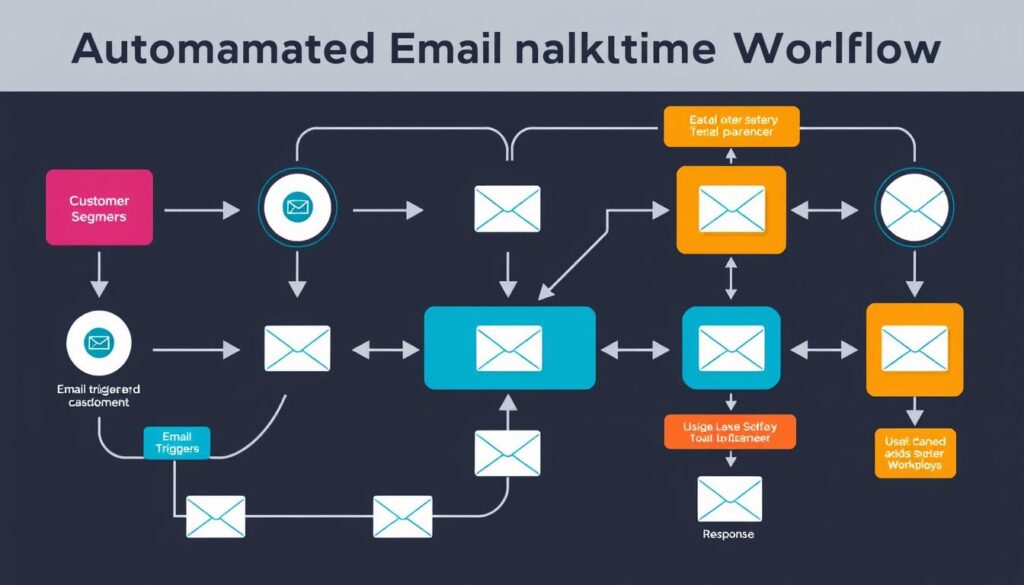Exploring automated email marketing strategy shows businesses a new way to talk smoothly with customers. This clear path helps firms stand out in the busy online world. With so many people using email, companies must use email marketing automation services to grow their reach and sales.
A good email campaign automation plan means more than just sending emails. It uses smart software to send tailored messages at the right time. This boosts marketing success and saves money by cutting down on simple, time-consuming tasks.
Email automation uses smart targeting and personalization, connecting deeply with what customers like and do. Emails sent this way help lead customers on their buying journey. This strategy’s success comes from data that guides constant improvement.
Key Takeaways
- Efficiency and time-saving benefits of automated email campaigns allow focus on strategic marketing initiatives.
- Enhanced ROI from reduced manual effort and precisely targeted communication.
- Personalization and segmentation lead to more impactful and relevant customer interactions.
- Timely and action-oriented emails result in improved click-through and conversion rates.
- Data-driven insights from email automation tools inform ongoing campaign improvements.
- Goal-oriented strategies offer a measurable framework for gauging content efficacy and success.
- Continuous A/B testing is critical for fine-tuning emails to achieve the best outcomes.
What is Automated Email Marketing?
Automated email marketing is leading the charge in changing how businesses talk to their customers. With a powerful marketing automation platform, companies can automatically send personalized messages. These are based on what users do or their behavior. This makes sure messages are relevant and arrive at the right time, making these tools key for marketing today.
Definition and Key Concepts
Automated email marketing uses software to send emails automatically to people and customers. It uses data about users to send out the right messages at the right time. This includes sales promos, info messages, and personalized hellos. The big wins of using automated email tools are better interaction with customers, quicker replies, and top-notch campaign control. And all without constant manual work.
Benefits of Automation
Using automated email marketing smartly brings a lot of pluses. It stops marketers from doing the same tasks over and over. This lets them be more creative with campaigns and planning. Here are the ways businesses benefit:
- Timely Responses: Automated emails can act right away to what customers do. This keeps customers involved.
- Increased Personalization: Tailoring emails based on personal likes and actions makes messages hit home more.
- Scalability: These platforms can deal with a lot of data and interactions at once. This is great for growing businesses.
- Cost Efficiency: Automating emails saves money on labor and cuts down mistakes made by people.
Also, marketing automation’s focus on data lets strategies get better over time. They use real-time feedback and behaviors. This means marketing actions keep improving and becoming more effective.
| Metrics Improved by Automated Email Marketing | Statistic |
|---|---|
| Conversion Rates with Automated Emails | 180% higher than batch emails |
| Revenue from Automated vs. Manual Emails | 320% higher revenue from automated emails |
| ROI from Email Marketing | $42 for every $1 invested |
How Automated Email Marketing Works
Understanding automated email marketing can boost your engagement and conversion rates. By using email automation services and top-notch software, companies can set up deeply personal communication. These depend on what users do and like.
Understanding Workflows
Automated email marketing revolves around creating smart workflows. These are email sequences triggered by specific actions. They match a customer’s journey, responding to how they interact with your brand.
For instance, 74% of users expect a welcome email when they subscribe. These first automatic emails get way more attention and clicks than normal ones, making much more money per email. This shows how well automation can work when set up right.
Email Triggers and Actions
Email triggers are user actions that start a custom email sequence. These actions aim to keep the user interested and active. Common triggers are signing up, buying something, or leaving items in a cart.
About 70% of online shoppers leave their carts. Automated emails bring them back by reminding them what they left. They might also suggest other items they could like, boosting sales from these emails a lot. This helps get back potentially lost sales and makes shopping more personal and timely.

Using the right email software, businesses can send messages at the perfect time. Adding real-time data makes every email more relevant and engaging. From welcome emails to reminders about abandoned carts, each message helps strengthen the bond with the brand. This highlights how valuable email automation is in the digital marketing world today.
Choosing the Right Automated Email Marketing Tool
Starting with automated email marketing requires picking the best software. It’s key to find a tool that fits well with your budget and strategic goals. It should also integrate well with the technology you already use.
Top Platforms to Consider
Mailchimp and Hubspot are top choices in email marketing automation. They offer a wide range of features for different business sizes. Mailchimp is great for small to medium businesses with its easy-to-use interface and affordable prices. Hubspot is better for larger businesses that need strong CRM features to connect email marketing with sales and services.
Key Features to Look For
The right features in email automation software can enhance your marketing. Look for advanced segmentation to send tailored messages to specific groups. Also, in-depth analytics help improve strategy and ROI. Real-time personalization and a user-friendly design can boost engagement and simplify campaign management.
- Advanced Segmentation: Tailor messages to specific user behaviors and demographics for better targeting.
- In-depth Analytics: Access to detailed analytics helps fine-tune strategies for better results.
- Real-time Personalization Capabilities: Customize content dynamically to increase engagement and conversions.
- User-friendly Design: An intuitive interface makes launching email campaigns easier for marketing teams.
Your business’s unique requirements should guide your software choice. Consider the complexity of automation you need, scalability, and how well it needs to work with other systems like eCommerce or CRM.
Using automated email marketing boosts engagement and conversions, building strong customer relationships. By choosing the right tools, businesses can significantly improve their marketing outcomes. This makes automated email marketing a vital part of digital marketing strategies.
Building Effective Email Campaigns
Email marketing automation services are key for today’s digital marketing strategies. Creating a strong automated email marketing strategy combines technology, data analysis, and creative messaging. Let’s explore how to create campaigns that engage and bring in good returns.
Crafting Engaging Content
To grab your audience’s attention, making engaging content is crucial. Essential elements include compelling subject lines under 50 characters and clear calls-to-action. Emotionally rich stories, like those in Charity: Water’s campaigns, can deepen audience connections. This approach may boost engagement and support for campaigns.
Segmenting Your Audience
Segmenting your email list is vital for a solid email strategy. Personalized emails, tuned to factors like demographics and buying history, boost engagement. By segmenting, you make your messages more relevant and effective. This technique has lifted open and click-through rates in various sectors.
A/B Testing for Success
A/B testing is crucial for refining email campaigns. Testing variations of your emails, from subject lines to visuals, identifies what appeals to your audience. Applying data-driven changes can raise conversion rates by 20%, demonstrating the value of informed marketing tweaks.
| Email Campaign Type | Goal | Example |
|---|---|---|
| Welcome Email Series | Bond with new subscribers | Typical welcome with incentives like exclusive content |
| Promotional Campaigns | Increase sales | Limited-time discounts or special offer announcements |
| Re-engagement Campaigns | Reactivate dormant subscribers | Engaging content to remind users of the value proposition |
| Transactional Campaigns | Confirm transactions and next steps | Order confirmation, shipping updates |
| Event/Announcement Campaigns | Inform about upcoming events or news | Webinar invites, new product launches |

In summary, enhancing email marketing involves detailed content creation, audience understanding through segmentation, and ongoing A/B testing. These methods are critical for achieving a high ROI. Email marketing yields an average of $36 return for every $1 spent.
Analyzing and Measuring Success
To make sure your email campaign strategies work, it’s key to look at important indicators and analyze with the right tools. Check the right metrics regularly and improve your emails to get people more involved and to earn more from your efforts.
Key Metrics to Track
It’s important to know which metrics tell you the most. Here are the key ones:
- Email and SMS marketing automations for lead generation and engagement metrics.
- Conversion rates show actions by recipients like form fill-ups, downloads, and buys.
- Open rates, along with social shares and engagement rates, show how much people interact with what you send.
- Advanced metrics such as customer lifetime value and lead scoring give deeper insights into long-term campaign benefits.
Tools for Data Analysis
Marketers use powerful email tools for a full view of campaign results. These tools help tweak emails and subject lines through A/B testing. They also offer detailed analysis like bounce, spam complaints, and forward/share rates.
To connect how engagements lead to earnings, some tools help calculate ROI. This links campaign results directly to business profit.
Find out how to track your marketing wins by checking out this guide on email marketing performance.
| Metric | Description | Impact |
|---|---|---|
| Conversion Rate | Number of actions divided by total emails delivered | Direct measure of campaign success |
| Engagement Rate | Interaction rates that include opens and social shares | Shows how much customers are getting involved |
| Bounce Rate | Percentage of visitors who leave the email page right away | Tells how good the landing pages are |
| ROI | Money made from campaigns divided by cost of them | Checks the financial success overall |
Common Challenges in Automated Email Marketing
In automated email marketing, facing obstacles is common. Knowing these issues helps businesses deal with them better. This improves their marketing efforts. It’s vital to address deliverability and spam filter avoidance for any marketing automation tool to succeed.
Deliverability Issues
Ensuring emails reach the inbox is a big challenge. This task involves careful management of email lists and understanding bounce rates. Deliverability can suffer from poor data, old lists, or a bad sender reputation. It’s important to keep up with the latest rules and follow best practices to keep a good reputation with internet service providers (ISPs).
Avoiding Spam Filters
Avoiding spam filters is key. Make sure your emails meet the standards set by email services. Writing clear subject lines, offering easy unsubscribe options, and avoiding too many links or salesy language helps. Also, regularly testing and updating email campaigns can increase your chances of reaching the inbox.
| Common Challenge | Impact on Marketing | Strategies to Overcome |
|---|---|---|
| Deliverability Issues | Reduces effectiveness | Regular data cleansing, adherence to sending best practices |
| Spam Filter Triggers | Decreases open rates | Optimize email content, subject lines, and sending frequency |
| Email List Outdating | Lowers campaign relevance | Continuous list segmentation and regular updates |
| Non-compliance with Laws | Potential legal penalties | Maintain rigorous compliance with GDPR, CCPA |
| Lack of Personalization | Impacts customer engagement | Utilize advanced analytics for tailored experiences |
By tackling these frequent challenges in automated email marketing, marketers can greatly improve their campaigns. Keeping a flexible strategy that includes ongoing changes and embracing new technologies is crucial. This helps to navigate through these hurdles effectively.
Best Practices for Automated Email Marketing
In the world of email marketing automation services, following top practices is key. These methods boost your strategy and connect well with your audience. Getting the timing and frequency right enhances engagement. This is seen in Travel, Hospitality, and Retail with high success. Personalization and adherence to rules build trust with your audience, helping open rates. These rates average at 15.68% in e-commerce.
Timing and Frequency
The timing of your emails should match to your customers’ life. For example, automotive emails convert at a rate of 3.4%. This shows timing is crucial for impact. Also, watching how often you send emails keeps your audience interested without feeling bombarded.
Personalization Strategies
Personalization in emails is more than using names. It includes tailoring content based on customer behavior, improving revenue by 18% in finance. For instance, in education, personalized emails help in student interaction. This boosts open and response rates through tailored messages.
Compliance with Regulations
Following laws, like the CAN-SPAM Act, is essential. 62% of healthcare firms use email segmentation legally and thoughtfully. This practice maintains your brand’s reputation and keeps email campaigns within legal bounds. It builds customer trust and loyalty too.
FAQ
What is the definition of automated email marketing?
Automated email marketing uses software to send emails based on schedules or actions. It helps make communication smooth and personal with people.
What are the key benefits of implementing automation in email marketing?
Benefits include more efficiency, better content targeting, improved customer connection, and growth for businesses.
How do automated email workflows function?
They send emails automatically based on specific rules and triggers. These could be when someone signs up or buys something.
What should I consider when choosing an automated email marketing tool?
Consider the tool’s complexity, how it works with other systems you use, and its cost. Also, think about features and how easy it is to use.
What features are essential in the best email automation software?
Look for good segmentation, analytics, personalization, user-friendly design, and tool integration.
How is engaging content crafted for email campaigns?
Create content by knowing your audience, using interesting subject lines, and adding visuals. Include clear actions for users to take.
Why is segmenting your audience important in automated email marketing?
Segmenting lets you create messages for specific audience groups. This can lead to more engagement and better results.
How does A/B testing enhance the success of email campaigns?
A/B testing compares email versions to find what works best. This helps improve your email campaigns over time.
What metrics should be tracked to analyze the success of automated email campaigns?
Track open rates, click-through rates, conversions, and ROI. These metrics show how people interact with your emails and their impact.
Which tools can help with data analysis for email marketing automation services?
Many platforms offer analytics tools. Also, you can use external tools for deeper insights into your campaigns.
What are common deliverability issues in email marketing automation?
Issues include emails marked as spam, emails bouncing, and being blacklisted due to bad sending practices.
How can I avoid spam filters with my automated email marketing?
Keep your email list clean, make content useful, respect email guidelines, and allow easy unsubscribing. Follow laws like CAN-SPAM.
What best practices should be followed for the timing and frequency of automated emails?
Align emails with customer’s journey and preferences. Don’t send too many emails to avoid bothering subscribers.
How can I employ personalization strategies in my automated email campaigns?
Use data to customize emails with names, past actions, and preferences. This makes emails feel more personal.
Why is compliance with regulations like CAN-SPAM important in automated email marketing?
Following laws avoids legal trouble and keeps trust with your audience. It shows respect for privacy and ethical practices.



